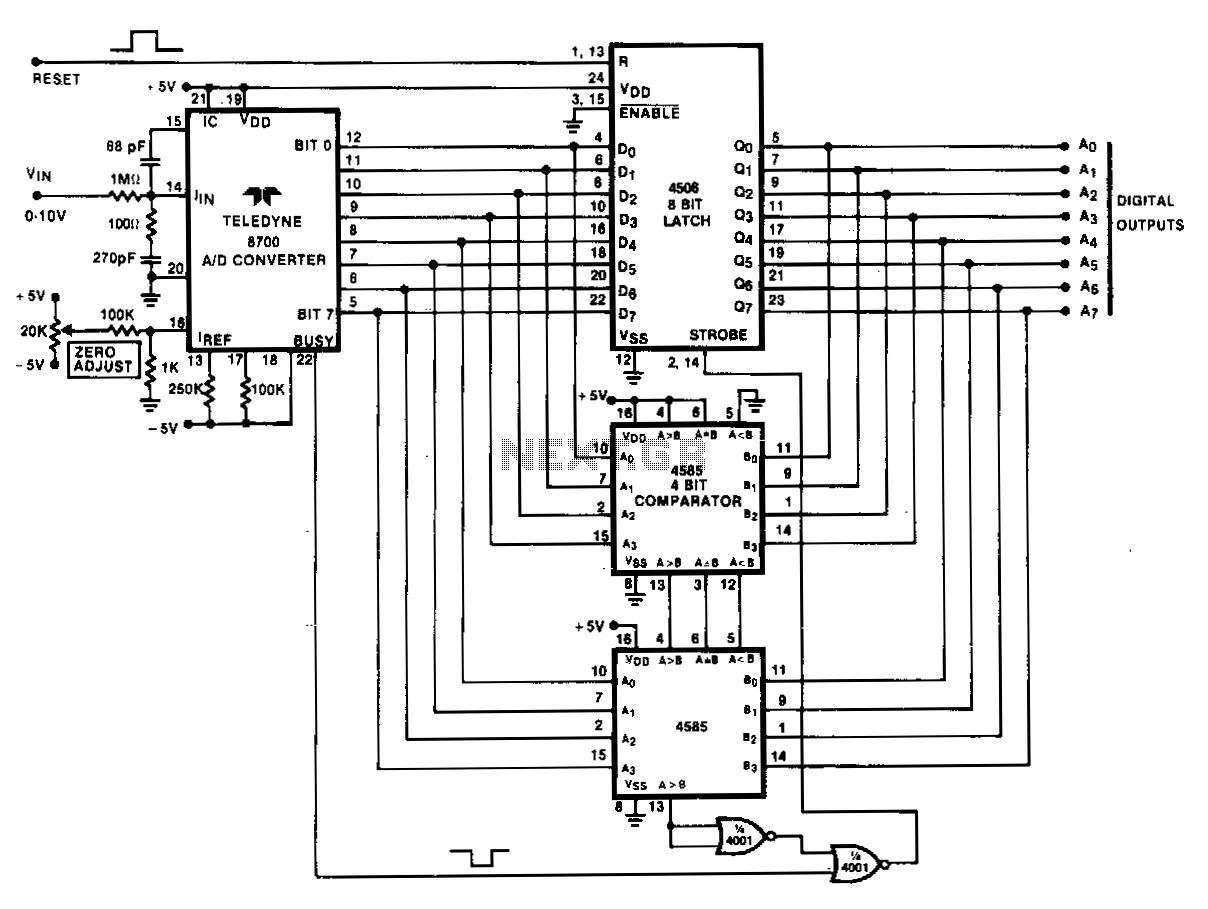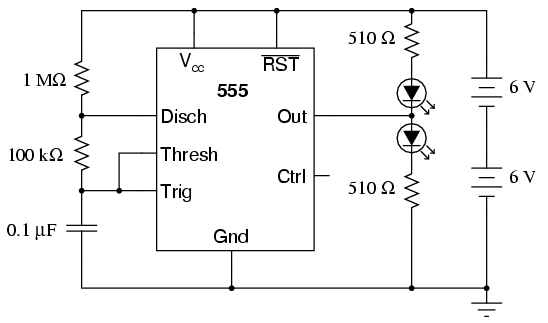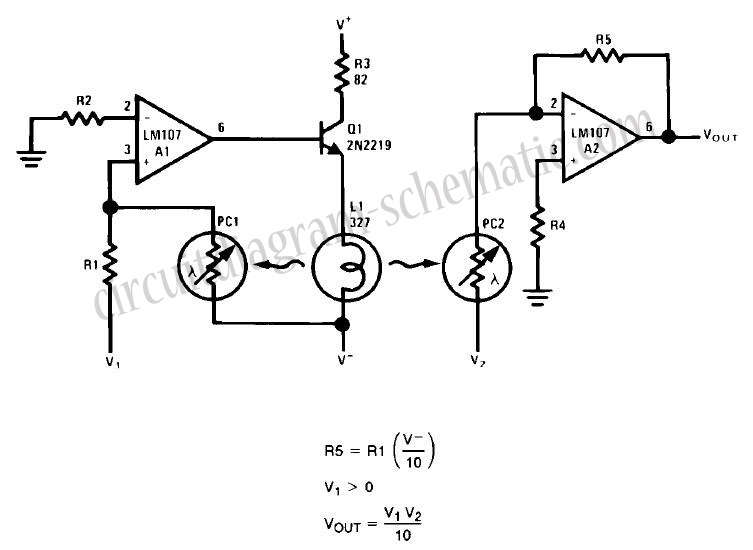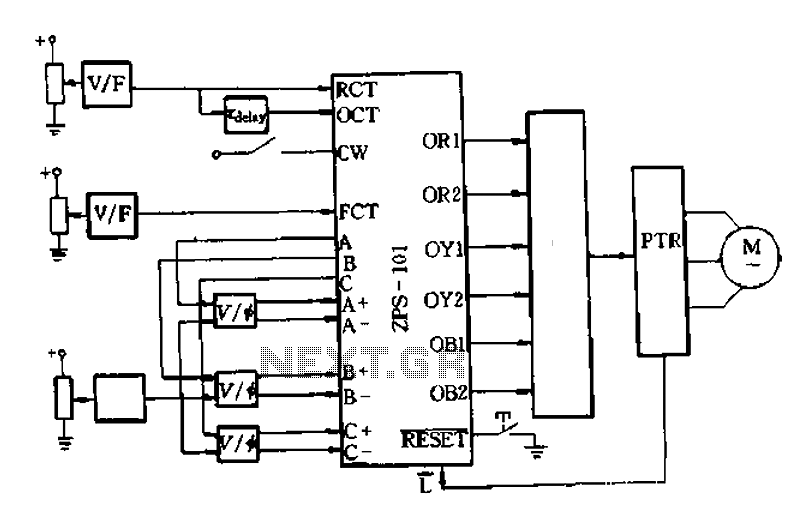
9700s Analog Synth Modules
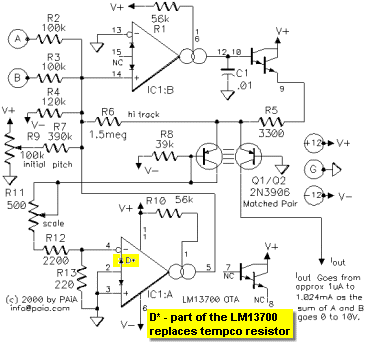
Circuits that utilize a temperature compensating resistor exhibit minor errors because the temperature coefficient's resistance varies as a function of temperature T, rather than the theoretically ideal inverse, 1/T. The prevalence of tempco circuits indicates that this residual error is generally acceptable for most users; however, it is absent in the 9720 model. An example illustrates a system that operates from 1 µA to 1.024 mA in response to a control voltage (CV) change ranging from 0V to 10V. The full schematic and additional details can be found on the 9720 page. The frequency response to control voltage is scaled such that a 1.0V increase in control voltage results in a one-octave change in frequency, commonly referred to as V/oct scaling or, less frequently, "exponential response." While 1.0V/octave is the most prevalent exponential scale factor, classic synthesizers may also utilize 0.8V/oct and 1.2V/oct, and all modules can be calibrated to accommodate these scale factors.
The FatMan synthesizer can be considered a comprehensive super-module containing all necessary components to create a complete instrument voice. Its audio output is compatible with the audio inputs and outputs of various modules, and the MIDI Thru of the midi2cv8 can connect directly to FatMan's MIDI In, enhancing compatibility and complementarity. It is possible to adapt connectors to be compatible with the power supply in use; for instance, when using a Blacet Research PS-CONN distribution board, it may be necessary to acquire 0.156" connector housings and pins from Blacet. When using ±15V regulated supplies, it is crucial to short out the isolating resistors R1 and R2 on the 97xx board. Care must be taken to avoid interchanging the (G) and (sg) connections on any 97xx modules, as this can disrupt the module's Star Ground system and introduce noise. If the power supply features only a single ground, separate wires should be run from the (G) and (sg) of each 97xx module back to this common ground.
DC Coupled indicates that the modules do not have a lower frequency cut-off point. For example, the VCAs in the 9710 module can transmit signals with a frequency of 0.0 Hz, which allows them to function as voltage-controlled attenuators for control voltages (CVs). A typical application might involve modulating the amplitude of an LFO to influence a pitch source for trills at the leading or trailing edges of notes. The modulation of one LFO by another can yield a diverse array of interesting effects. Additionally, the 9730 VCF can process slowly varying bio-frequency voltages, such as those generated by EEG or EMG devices.
The midi2cv8 features a Ring terminal, which is connected to the collector of a transistor that activates when the CV output exceeds approximately one volt. This transistor can control various electrical loads, such as relays and small motors, functioning as a switch that completes a circuit to ground. An illustration provides examples of this configuration, showing that one side of a load, like a lamp, connects to the Ring terminal while the other side connects to the load's power supply. This power supply may originate from the 9700’s power or, for heavier loads, from a different voltage source up to about 35V. The transistor can support a collector current of up to 100 mA. The midi2cv8's Mode 4, known as "Continuous Controller" mode, is particularly beneficial for these applications, where CC data can be interpreted as switch states, with 0 representing an open switch and 127 representing a closed switch, or vice versa.Circuits that use a temperature compensating resistor have a small error because the tempco`s resistance is a function of temperature T, rather than 1/T as is theoretically perfect. The fact that tempco circuits are de-riguer attests that this remaining error is not significant to most people, but still.
it is not present in the 9720. The illustration shows a working example that pumps from 1uA to 1. 024mA in response to a 0V. to 10V. CV change. Full schematic and other details on the 9720 page. V/octave. The response of frequency to Control Voltage is scaled so that a 1. 0V. increase in Control Voltage produces a 1 octave change in frequency. This is commonly called V/oct scaling or less commonly "exponential response". While 1. 0V. /octave is the most common exponential scale factor there are also classic synths that work to 0. 8V. /oct and 1. 2V/oct and all modules can be calibrated to these scale factors as well. In the most limited sense, that`s true; but it`s a very narrow view of the situation. It`s better to think of our FatMan as a single super-module with all the elements needed to produce a complete instrument voice. The FatMan audio output is compatible the audio ins/outs of the modules and the MIDI Thru of the midi2cv8 can chain directly to FatMan`s MIDIIn, so on this higher level they`re very compatible and very complementary.
You sure can. You may need to change connectors to ones compatible with the supply you`re using. For example, if using a Blacet Research PS-CONN distribution board you will probably want to get some. 156 connector housings and pins from Blacet. When using +/-15V regulated supplies always short out isolating resistors R1 and R2 on the 97xx board.
Be very careful not to interchange (G) and (sg) on any 97xx modules as this corruption of the module`s Star Ground system will guarantee "noise". If the power supply has only a single ground, run separate wires from the (G) and (sg) of each 97xx module back to this single ground DC Coupled means that the modules have no lower frequency cut-off point.
The VCAs in the 9710 Module, for example, can pass a signal with 0. 0 Hz. frequency - in other words a DC Control Voltage. It`s important because it allows the VCAs to serve as voltage controlled attenuators for CVs, a typical example might be ramping the amplitude of an LFOmodulating a pitch source for a trill to the leading or trailing edges of notes. The amplitude of one LFObeing modulated by a second LFO can produce a wide range of interesting effects.
As a somewhat more esoteric example, the 9730 VCF can process very slowly varying bio-frequency voltages such as those that come from an EEG, EMG or similar bio-feedback apparatus. Yes you can, it`s what the ever mysterious Ring terminal is for. The Ring terminal of a midi2cv8 is connected to the collector of a transistor that is turned on when the CV output is greater than a volt or so.
This transistor can be used to control a variety of electrical loads such as relays and small motors. Think of it as a switch that closes to complete a circuit to ground. The illustration shows some examples. Notice that one side of the lamp or other load connects to the Ring terminal of the jack while the other connects to the power supply for the load.
This power supply may be the 9700`s power or for heavier loads it may be some other voltage source up to about 35V. The transistor can handle up to 100mA. of collector current. The midi2cv8 Mode 4, "Continuous Controller" mode is the most useful for these applications. CC data can be treated as switch opening and closing by having 0 represent switch open and 127 represent switch closed- or vice-versa
🔗 External reference
The FatMan synthesizer can be considered a comprehensive super-module containing all necessary components to create a complete instrument voice. Its audio output is compatible with the audio inputs and outputs of various modules, and the MIDI Thru of the midi2cv8 can connect directly to FatMan's MIDI In, enhancing compatibility and complementarity. It is possible to adapt connectors to be compatible with the power supply in use; for instance, when using a Blacet Research PS-CONN distribution board, it may be necessary to acquire 0.156" connector housings and pins from Blacet. When using ±15V regulated supplies, it is crucial to short out the isolating resistors R1 and R2 on the 97xx board. Care must be taken to avoid interchanging the (G) and (sg) connections on any 97xx modules, as this can disrupt the module's Star Ground system and introduce noise. If the power supply features only a single ground, separate wires should be run from the (G) and (sg) of each 97xx module back to this common ground.
DC Coupled indicates that the modules do not have a lower frequency cut-off point. For example, the VCAs in the 9710 module can transmit signals with a frequency of 0.0 Hz, which allows them to function as voltage-controlled attenuators for control voltages (CVs). A typical application might involve modulating the amplitude of an LFO to influence a pitch source for trills at the leading or trailing edges of notes. The modulation of one LFO by another can yield a diverse array of interesting effects. Additionally, the 9730 VCF can process slowly varying bio-frequency voltages, such as those generated by EEG or EMG devices.
The midi2cv8 features a Ring terminal, which is connected to the collector of a transistor that activates when the CV output exceeds approximately one volt. This transistor can control various electrical loads, such as relays and small motors, functioning as a switch that completes a circuit to ground. An illustration provides examples of this configuration, showing that one side of a load, like a lamp, connects to the Ring terminal while the other side connects to the load's power supply. This power supply may originate from the 9700’s power or, for heavier loads, from a different voltage source up to about 35V. The transistor can support a collector current of up to 100 mA. The midi2cv8's Mode 4, known as "Continuous Controller" mode, is particularly beneficial for these applications, where CC data can be interpreted as switch states, with 0 representing an open switch and 127 representing a closed switch, or vice versa.Circuits that use a temperature compensating resistor have a small error because the tempco`s resistance is a function of temperature T, rather than 1/T as is theoretically perfect. The fact that tempco circuits are de-riguer attests that this remaining error is not significant to most people, but still.
it is not present in the 9720. The illustration shows a working example that pumps from 1uA to 1. 024mA in response to a 0V. to 10V. CV change. Full schematic and other details on the 9720 page. V/octave. The response of frequency to Control Voltage is scaled so that a 1. 0V. increase in Control Voltage produces a 1 octave change in frequency. This is commonly called V/oct scaling or less commonly "exponential response". While 1. 0V. /octave is the most common exponential scale factor there are also classic synths that work to 0. 8V. /oct and 1. 2V/oct and all modules can be calibrated to these scale factors as well. In the most limited sense, that`s true; but it`s a very narrow view of the situation. It`s better to think of our FatMan as a single super-module with all the elements needed to produce a complete instrument voice. The FatMan audio output is compatible the audio ins/outs of the modules and the MIDI Thru of the midi2cv8 can chain directly to FatMan`s MIDIIn, so on this higher level they`re very compatible and very complementary.
You sure can. You may need to change connectors to ones compatible with the supply you`re using. For example, if using a Blacet Research PS-CONN distribution board you will probably want to get some. 156 connector housings and pins from Blacet. When using +/-15V regulated supplies always short out isolating resistors R1 and R2 on the 97xx board.
Be very careful not to interchange (G) and (sg) on any 97xx modules as this corruption of the module`s Star Ground system will guarantee "noise". If the power supply has only a single ground, run separate wires from the (G) and (sg) of each 97xx module back to this single ground DC Coupled means that the modules have no lower frequency cut-off point.
The VCAs in the 9710 Module, for example, can pass a signal with 0. 0 Hz. frequency - in other words a DC Control Voltage. It`s important because it allows the VCAs to serve as voltage controlled attenuators for CVs, a typical example might be ramping the amplitude of an LFOmodulating a pitch source for a trill to the leading or trailing edges of notes. The amplitude of one LFObeing modulated by a second LFO can produce a wide range of interesting effects.
As a somewhat more esoteric example, the 9730 VCF can process very slowly varying bio-frequency voltages such as those that come from an EEG, EMG or similar bio-feedback apparatus. Yes you can, it`s what the ever mysterious Ring terminal is for. The Ring terminal of a midi2cv8 is connected to the collector of a transistor that is turned on when the CV output is greater than a volt or so.
This transistor can be used to control a variety of electrical loads such as relays and small motors. Think of it as a switch that closes to complete a circuit to ground. The illustration shows some examples. Notice that one side of the lamp or other load connects to the Ring terminal of the jack while the other connects to the power supply for the load.
This power supply may be the 9700`s power or for heavier loads it may be some other voltage source up to about 35V. The transistor can handle up to 100mA. of collector current. The midi2cv8 Mode 4, "Continuous Controller" mode is the most useful for these applications. CC data can be treated as switch opening and closing by having 0 represent switch open and 127 represent switch closed- or vice-versa
🔗 External reference
